Lighting is a key part of home design, setting the mood and atmosphere in every room. It can make a space feel cozy or grand, depending on the lighting. This guide will show you how to use lighting to enhance your home’s ambiance.
Want to change the mood of any room with a few lighting choices? Learn how to layer light, use smart tech, and pick the right fixtures. Your living spaces will shine like never before.
Key Takeaways
- Incorporate multiple light sources, including floor lamps, table lamps, and overhead lighting, to create a well-lit and comfortable space.
- Adjust lighting heights and levels to establish the right ambiance for each room.
- Leverage smart technology and dimmers to control lighting based on your mood or activity.
- Experiment with decorative lighting fixtures and accent pieces to add visual interest.
- Prioritize energy-efficient lighting solutions to save money and reduce your carbon footprint.
Understanding the Fundamentals of Home Lighting Design
Creating the perfect lighting for your home is all about the three main types: ambient, task, and accent. Ambient lighting gives a general glow, making your space feel warm and cozy. Task lighting shines on areas where you do things, like cooking or reading. Accent lighting brings out special features, like artwork, adding beauty and interest.
Lighting greatly affects how a room feels. Soft, warm lights make a space feel cozy and welcoming. Bright, cool lights can make a room feel lively and energizing. By mixing these lights at different heights, you can make a space that looks good and works well.
Basic Principles of Light Layering
The secret to great home lighting is light layering. This means mixing ambient, task, and accent lighting to get the right feel. Here are some key tips:
- Begin with ambient lighting to cover the whole area evenly.
- Add task lighting for places you work, like kitchens or reading spots.
- Accent lighting should focus on special features or artwork, adding depth and interest.
- Play with light colors to set the mood, from warm to cool.
- Think about where and how high your lights are to balance your lighting.
Learning to layer light can turn any room into a beautiful and useful space. It meets your lifestyle and design tastes perfectly.
Essential Lighting Ideas for Every Room
Creating the perfect lighting for your home needs careful thought. Each room has its own needs and feel. Knowing the three main types of lighting helps you design a space that looks and feels great.
In the living room, mix floor lamps, table lamps, and dimmable overhead lights for a cozy feel. Ambient lighting from a central chandelier or pendant fixture gives a broad, open light. Task lighting from floor and table lamps focuses on specific areas. Accent lights, like wall sconces or LED strip lights, highlight special features or art, adding depth and interest.
Bedrooms need a softer, more relaxing light. Bedside lamps or wall sconces offer gentle, ambient light. Recessed ceiling lights or flush mounts add overall light. Accent lights, like reading lamps or dimmable wall sconces, make the space cozy and inviting for relaxing.
Bathrooms need both function and flattering light. Overhead lights, like recessed fixtures or vanity lighting, provide enough light for daily tasks. Wall sconces or mirrors with built-in lights add a warm, spa-like feel. Placing these lights right can make grooming and relaxing a pleasure.
| Room | Lighting Ideas |
|---|---|
| Living Room | Combination of floor lamps, table lamps, and dimmable overhead lighting |
| Bedroom | Bedside table lamps, wall sconces, recessed ceiling lights, or flush mounts |
| Bathroom | Overhead lighting, vanity lighting, and wall sconces |
| Kitchen | Bright overhead lighting, task lighting near work areas, and pendants or under-cabinet lighting |
Think about each room’s function and feel when planning your lighting. This way, you can make a lighting design that boosts your home’s style and comfort.
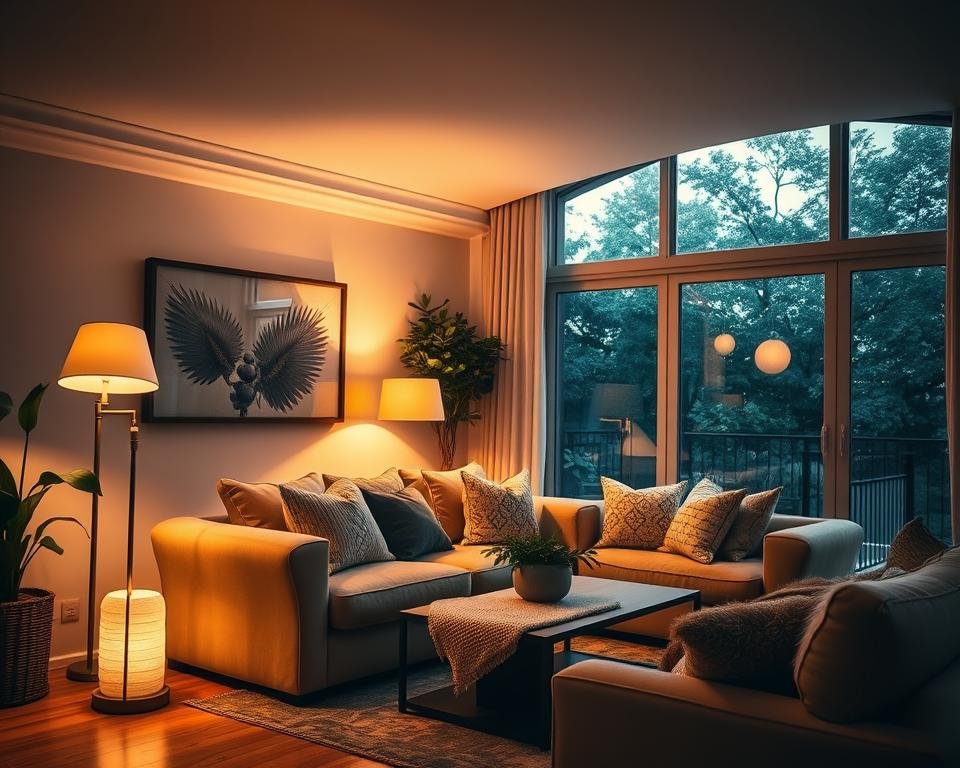
Creating the Perfect Living Room Lighting Setup
Creating the right lighting in your living room is key. It makes the space warm, inviting, and flexible. By mixing different lights, you get a space that looks great and meets your needs.
Floor and Table Lamp Placement Strategies
Start with floor and table lamps for a soft glow. Place them around the room for a diffused light. Use dimmable lights to change the brightness easily.
Overhead Lighting Solutions
Add overhead lights for more light. Dimmable recessed lights or a big pendant light are great. They let you change the mood with a switch. Mixing overhead lights, like a chandelier and spotlights, adds interest.
Accent Lighting for Artwork and Features
Use accent lighting to show off special parts of the room. Wall sconces, track lights, or floor lamps can focus attention. They add depth and interest.
| Lighting Type | Purpose | Examples |
|---|---|---|
| Ambient Lighting | Provides overall illumination and sets the tone | Floor lamps, table lamps, dimmable recessed lights |
| Task Lighting | Illuminates specific areas for focused activities | Reading lamps, under-cabinet lighting, desk lamps |
| Accent Lighting | Highlights architectural features, artwork, or decorative elements | Wall sconces, track lighting, adjustable floor lamps |
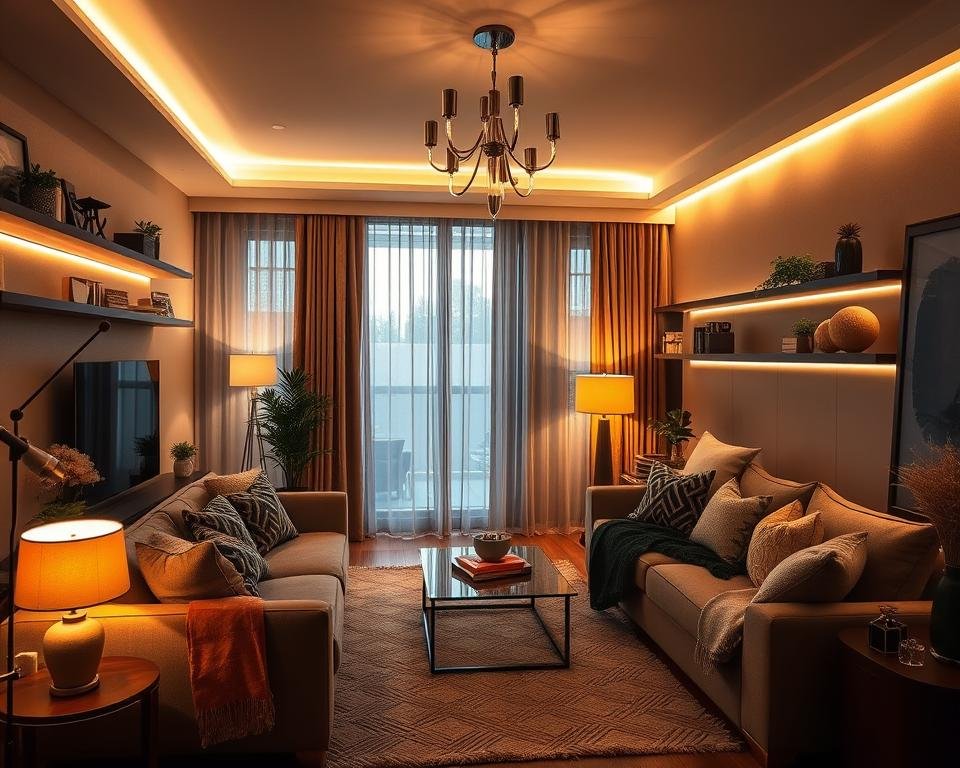
By mixing ambient, task, and accent lighting, you get a balanced room. It looks great and meets your needs, making the room feel welcoming.
Kitchen Lighting: Combining Function and Style
Creating the perfect kitchen lighting is all about finding the right mix of function and style. By using different lighting fixtures, you can make your kitchen both useful and beautiful. It becomes a space that meets your needs and looks great too.
At the heart of a well-lit kitchen is overhead lighting. Pendant fixtures are a top pick, with 50% of ideas featuring them. They offer plenty of light and add a stylish touch. Make sure to match the pendants with your kitchen’s decor for a unified look.
But overhead lighting isn’t enough. Task lighting is key for cooking and food prep. About 20% of ideas focus on placing task lights in important spots, like over counters and by the sink. LED lights under cabinets or recessed floor lights make these areas brighter and more functional.
| Lighting Idea | Percentage of Mentions |
|---|---|
| Pendant Fixtures | 50% |
| Diverse Materials | 30% |
| Task Lighting | 20% |
| Mismatched Pendants | 10% |
| Adjustable Heights | 15% |
| Thematic Coordination | 25% |
| Bold Color Accents | 5% |
To make your kitchen stand out, mix different lighting fixtures that match your kitchen’s look. Pendant lights with special materials or colors can bring personality. LED lights behind glass or resin backsplashes can also add to the atmosphere.

By blending useful and stylish lighting, you can turn your kitchen into a place that’s both practical and beautiful. Choose energy-saving options like LED bulbs. Also, add dimmers to change the lighting for different times and tasks.
Bedroom Lighting Solutions for Comfort and Relaxation
Creating a cozy bedroom is key for a good night’s sleep. The right lighting can make a big difference. By mixing ambient, task, and accent lighting, you can make a space that feels just right for you.
Bedside Lighting Options
Bedside lights set the mood in your bedroom. Wall sconces and table lamps provide focused light for reading. They also add to the room’s feel. Choose dimmable light sources to change the light’s brightness. This lets you adjust the mood from cozy to bright.
Ambient Lighting for Peaceful Environments
Ambient lighting, like recessed ceiling lights or floor lamps, creates a warm glow. Dimmable LED bulbs in the 2700K-3000K range are perfect for a calm atmosphere. Try different lighting setups to find the perfect mix of light and comfort.
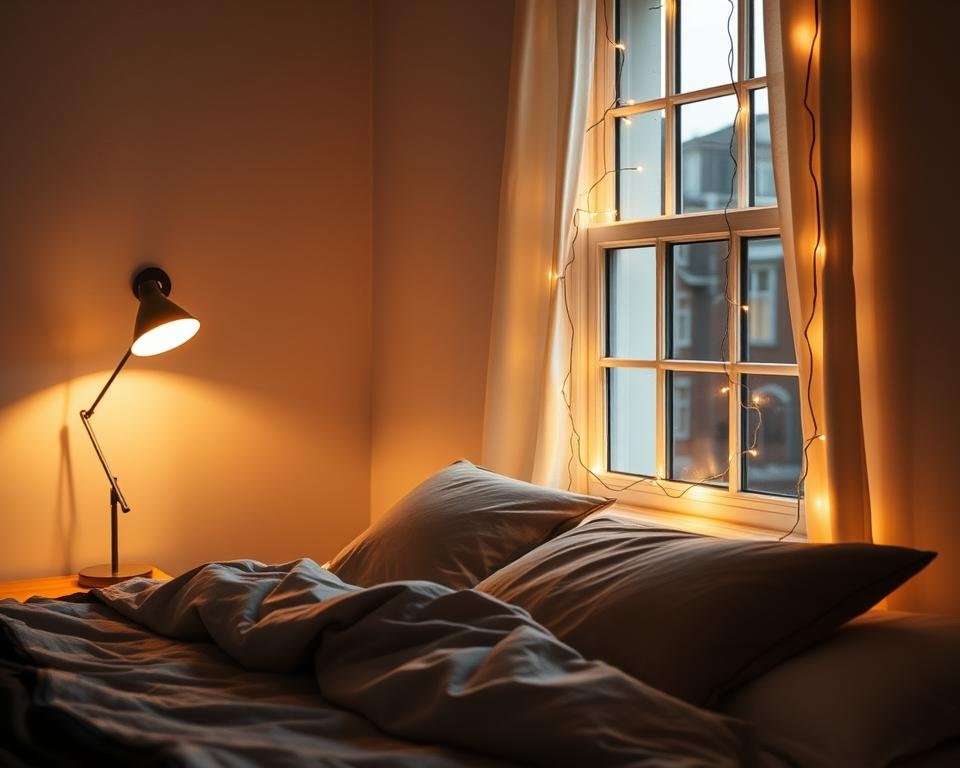
Combining bedside and ambient lighting makes your bedroom a peaceful retreat. Discover the many ways to light up your space. Turn it into a cozy haven where you can relax and unwind.
Bathroom Lighting Techniques for Perfect Illumination
Creating the perfect bathroom lighting is all about mixing function and comfort. By layering different lights, you can make your bathroom feel like a spa. At the same time, you’ll have enough light for everyday tasks.
Begin with overhead lights like recessed fixtures or a ceiling light. These provide overall light for the room. Make sure this light is strong enough to see well, even in the shower.
Then, focus on the vanity area. Use wall-mounted sconces or vanity lights on either side of the mirror. Experts say vanity lighting should have at least 150 watts, with lights 36 to 40 inches apart.
To add to the relaxing feel, add more lights like dimmable LED strips in the shower or around a freestanding tub. Make sure these lights are waterproof and damp-rated for wet areas.
Choose light bulbs with warmer colors to feel more natural. Halogen bulbs give a crisp white light, while LEDs are energy-saving and last long.
By mixing practical lighting with cozy touches, you’ll have a bathroom that looks great and works well. It’s the perfect place to start and end your day.
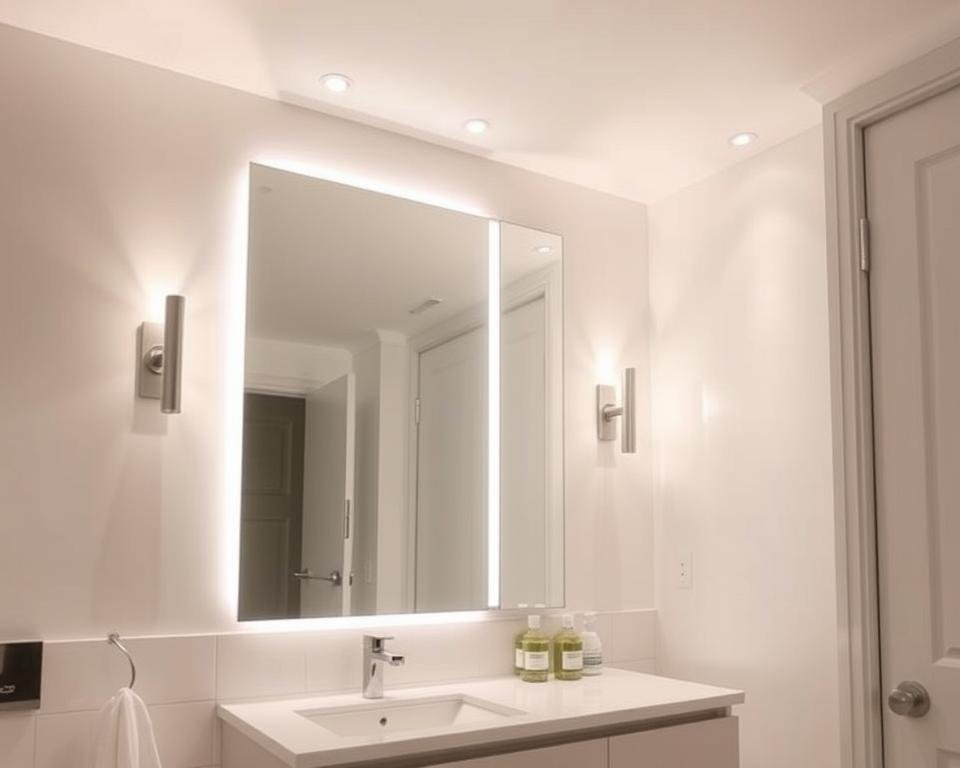
Smart Lighting Technologies and Automation
Technology keeps getting better, making smart lighting in our homes more advanced. Now, you can change your lights with just your voice, thanks to devices like Amazon Echo Plus. Smart bulbs and connected systems let you control your lights with your phone, saving energy and setting the mood easily.
Voice-Controlled Lighting Systems
Voice-activated assistants have changed how we control our homes. With Amazon Alexa and Google Assistant, you can manage your lights with voice commands. This makes it easy to set the mood without getting up.
Smart Bulbs and Connected Solutions
Smart lighting technologies offer more than just convenience. LED bulbs and smart plugs can turn on and off by themselves. They can follow your schedule or react to motion or alarms. These systems also let you change colors, perfect for any event.
Smart lighting and automation make our homes more comfortable and save energy. They let you control your lights from anywhere, creating a personalized and efficient home.
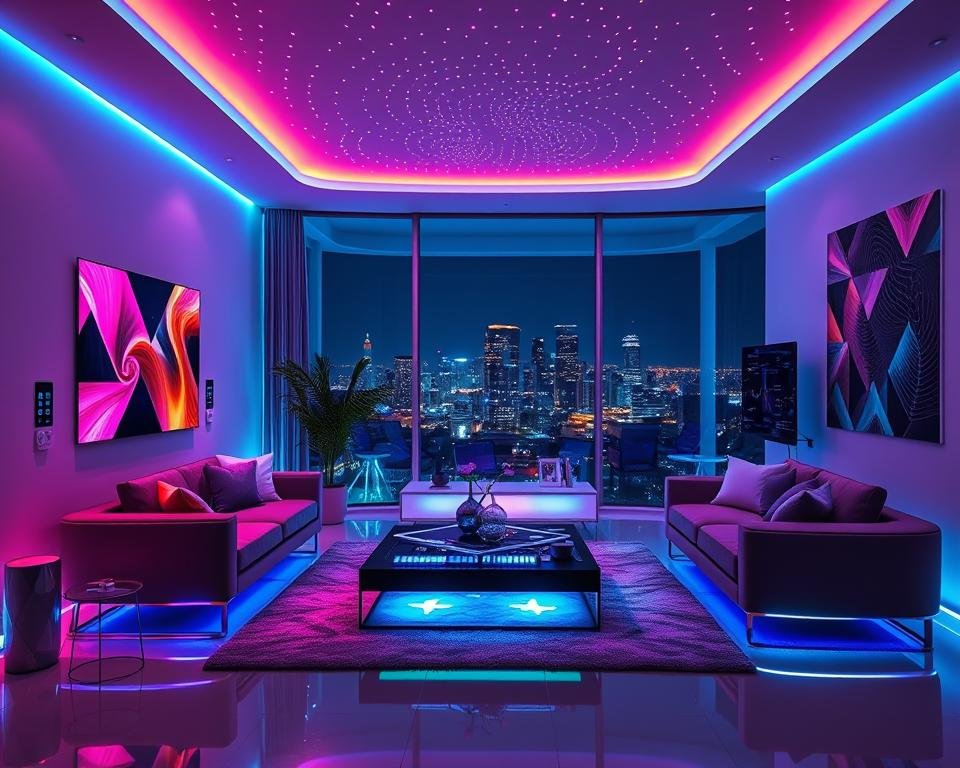
“Smart lighting automation allows for customization of lighting in a room, potentially changing its perceived size and aesthetics.”
Energy-Efficient Lighting Solutions
Lighting is a big part of our homes, using about 15% of our electricity. But now, thanks to new tech, we can save a lot on bills and make our homes cozy. LED (light-emitting diode) bulbs are a great choice.
LEDs have changed the game in lighting. They use way less energy and last much longer than old bulbs. Switching to LEDs can save a household around $225 a year. They’re good for the planet and your wallet.
LEDs also offer lots of lighting ideas and ways to customize. You can pick from many colors and brightness levels. This lets you match your lighting to your home’s style and mood.
| Feature | Incandescent Bulbs | LED Bulbs |
|---|---|---|
| Energy Efficiency | 100% energy used as heat | Up to 90% energy efficient |
| Lifespan | 1,000 hours | Up to 25,000 hours |
| Cost Savings | Higher energy costs | Significant energy and maintenance savings |
For outdoor energy-efficient lighting, LEDs are a top pick. They handle tough weather well and save a lot of energy. This makes them a smart choice for outdoor lighting.
As LED prices drop, more people can switch to them. LEDs help the environment and save money. They also make your home brighter and more welcoming.
“By 2027, widespread use of LEDs could lead to annual electricity savings equivalent to the output of 44 large electric power plants, resulting in over $30 billion in total savings.”
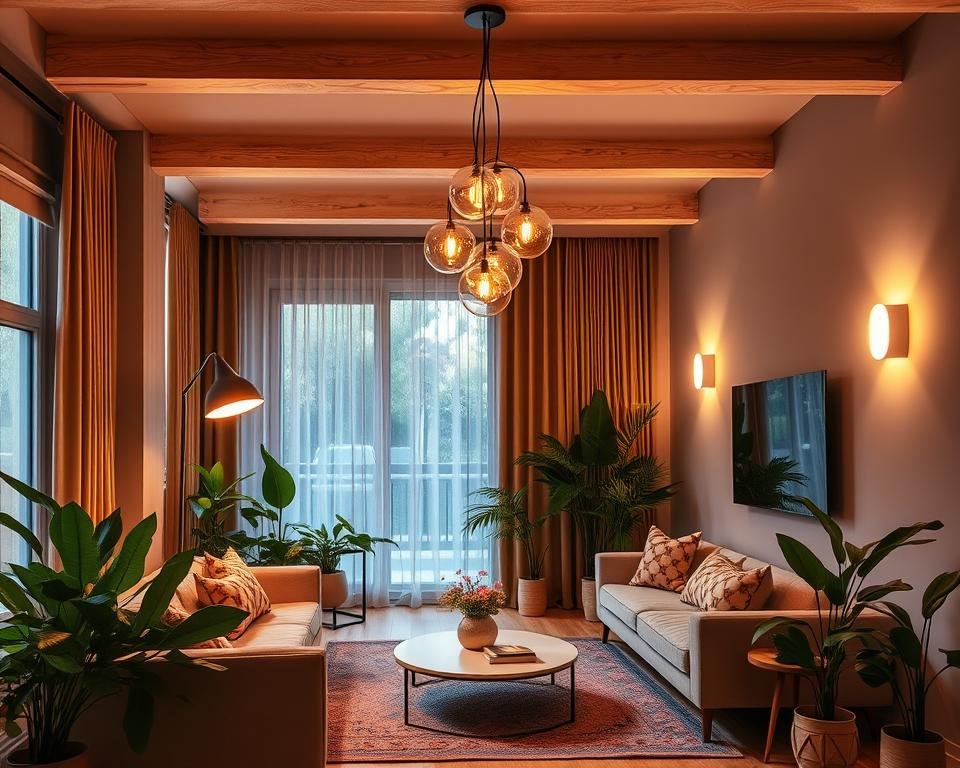
Natural Lighting Integration and Enhancement
Using natural lighting can change how your home feels and works. By picking the right window treatments and using daylight well, you can mix natural and artificial light. This makes your home look better and work better too.
Window Treatment Strategies
Choose sheer curtains or blinds that you can adjust. They let you control the light and keep your privacy. These treatments can be changed to let in the right amount of light, making your home feel cozy and inviting.
Also, placing mirrors smartly can bounce natural light around. This makes rooms look brighter and bigger.
Maximizing Daylight Usage
Think about adding skylights or light tubes in rooms with few windows. These features bring sunlight straight into your home. Open floor plans help natural light move around, lighting up every part of your home.
Keeping your windows clean is key. It lets sunlight shine in freely, making your home brighter.
Using natural light in your design can cut down on the need for artificial light. This saves energy and makes your home more eco-friendly. By mixing natural and artificial light well, you can make a space that looks good and fits your life.
| Natural Lighting Strategies | Benefits |
|---|---|
| Sheer curtains or adjustable blinds | Control light levels while maintaining privacy |
| Strategically placed mirrors | Reflect natural light to make spaces feel brighter and larger |
| Skylights or light tubes | Channel sunlight directly into rooms with limited window access |
| Open floor plans | Allow natural light to permeate every corner of the home |
| Clean windows | Boost brightness by allowing unobstructed sunlight entry |

By using these natural lighting tips, you can make a home that looks great and feels welcoming. It will also improve your home’s lighting design.
Outdoor Lighting Design and Implementation
Make your outdoor spaces better with well-thought-out lighting. You can make your backyard magical with the right lights. Think about using different types of lighting to make your space look great and work well.
Start with ambient lighting for a warm feel. Use string lights and lanterns to light up your paths and seating areas. This makes your space feel welcoming and perfect for fun.
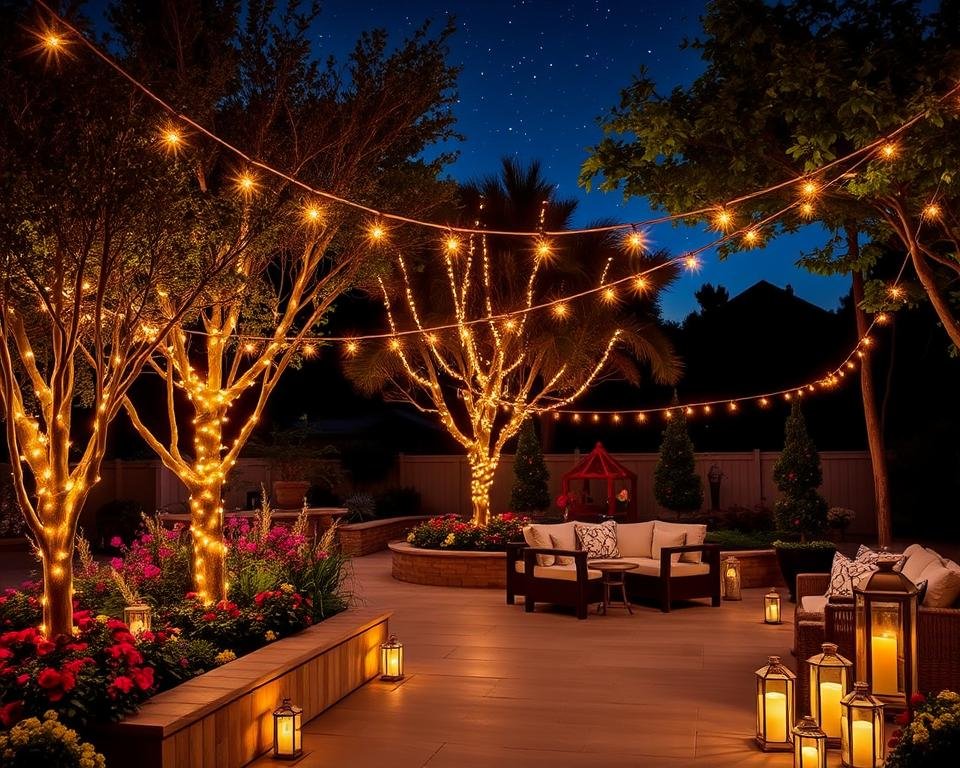
Accent lighting is key for showing off special features. Use spotlights to highlight trees or statues. This makes your space feel like a private getaway.
Choose energy-saving LED lights for your bulbs. They last long and save money. Try different colors to change the mood, from cozy to modern.
Make your lighting smart with tech and dimmers. This lets you change the light to match your mood. With the right lights, your backyard will be a bright and beautiful spot at night.
Choosing the Right Light Bulbs and Color Temperatures
When it comes to home lighting ideas and lighting design, picking the right light bulbs is key. It greatly affects the feel and use of a room. Knowing about lumens and color temperature is essential for the perfect lighting.
Understanding Lumens and Wattage
Lumens measure a light bulb’s brightness, not wattage. For general home use, aim for about 800 lumens. This level is bright enough but not too harsh.
Color Temperature Selection Guide
- Warmer color temperatures (2700K-3000K) create a cozy, inviting atmosphere, perfect for living rooms and bedrooms.
- Neutral color temperatures (3100K-4500K) offer a balanced, clear light, suitable for task-oriented areas like kitchens and home offices.
- Cooler color temperatures (4600K and above) provide a bright, energizing light, often used in specialized applications or spaces that require maximum visibility.
When picking light bulbs, try out different color temperatures in each room. Mixing warm and cool lighting can add depth and interest to a space.
| Room | Recommended Color Temperature Range (Kelvins) |
|---|---|
| Bathroom | 3000K – 4000K |
| Kitchen | 2700K – 3500K |
| Living Room | 2400K – 3000K |
| Home Office | 3000K – 3500K |
Understanding lumens and color temperature helps you create lighting ideas and lighting design that improve your home’s feel, function, and energy use.
Decorative Lighting Fixtures and Statement Pieces
Decorative lighting fixtures can make your home stand out. They range from eye-catching chandeliers to unique floor lamps. These elements can change the feel and look of any room.
In the dining room, a bold chandelier can make a big impact. Pendant lights are also great, adding personality to your space. Decorative sconces in hallways and bedrooms offer both style and function.
Mid-century-inspired lighting is becoming more popular. A black and brass fixture can add vintage charm to a living room. A custom Brothers Dressler chandelier in a Toronto condo dining area shows how lighting can enhance a space.
Lighting doesn’t have to be traditional. A colorful floor lamp can add whimsy to a room. A linear light over a bathroom vanity can bring an industrial feel.
Updating your lighting doesn’t have to be expensive. A coat of black spray paint can change a metallic fixture. In the kitchen, a sleek Tube light by AndLight for Klaus can match minimalist decor.
Decorative lighting fixtures can be the highlight of any room. They can make your home’s lighting design stand out. From chandeliers to floor lamps, these pieces can elevate your space.
“A dramatic multi-arm fixture from Apparatus serves as a striking centerpiece, enriching the ambiance of the [dining] room with statement lighting.”
A multilayered ceiling pendant can blend different styles in a principal bedroom. In a ’60s home, a funky Orbit chandelier by Patrick Townsend fits perfectly with the vintage vibe.
For a modern touch in a classic setting, a mod globe pendant light in a funky bathroom works well. It complements a vintage portrait in the space.
Decorative lighting fixtures can truly transform a room. They serve as focal points that enhance the design. Whether it’s a chandelier, a floor lamp, or a sconce, these elements add personality and style to your home.
Budget-Friendly Lighting Updates and DIY Ideas
Upgrading your home’s lighting doesn’t have to be expensive. With a bit of creativity and DIY skills, you can refresh your space affordably. Here are some budget-friendly lighting ideas to revamp your rooms:
- Give old light fixtures a new look. A simple paint job and new shades can modernize them. For example, a bathroom vanity light was updated with matte black spray paint and seeded glass shades for under $60 per fixture.
- Find unique lighting pieces at thrift stores. Vintage items from Facebook Marketplace or secondhand stores can be rewired, repainted, and customized. This way, you can create unique statement pieces.
- Look for affordable new fixtures. IKEA’s pendant lights, for instance, cost around $100 for a set of three. Amazon also offers affordable alternatives to high-end styles.
Be creative with everyday items too. You can turn baskets into unique pendant lights. And, can fan lights can get a new look with a fresh shade. With a bit of effort and imagination, you can achieve stylish lighting updates without spending a lot.
| Lighting Fixture | Cost |
|---|---|
| Bathroom Vanity Light | $192 |
| Bathroom Sconce #11 | $27 |
| Bathroom Sconce #8 | $124 |
| Affordable Vanity Lights | $6 – $10 |
| Affordable Overhead Fixtures | $10 – $44 |
By exploring budget-friendly lighting ideas and DIY projects, you can change your home’s feel without spending a lot. Get inspired and start your own lighting makeover today!
“Lighting can make or break a room – it’s the finishing touch that truly sets the mood and atmosphere.”
Conclusion
Effective lighting ideas and lighting design are key to making your home beautiful and useful. By mixing different lighting types, using smart tech, and thinking about each room’s needs, you can make a space that looks great and fits your life.
Lighting balance is important. Mix artificial lights with natural light and pick the right colors for the mood you want. Feel free to try out unique fixtures and bold choices. These can really make your home stand out.
Now, you have the knowledge to light your home perfectly. Use light to make your home both beautiful and practical. Let your home reflect your style and what you like.
FAQ
What are the main types of lighting used in home design?
Home design uses three main types of lighting. Ambient lighting lights up the whole room. Task lighting focuses on areas where you do activities. Accent lighting highlights special features or adds visual interest.
How can I create a layered lighting approach in a room?
For layered lighting, mix floor lamps, table lamps, and dimmable overhead lights. Place them at different heights. This balance enhances the room’s look and function.
What are some kitchen lighting ideas to consider?
Kitchens need bright overhead lights for overall light. Add task lights near countertops and the island. Pendant lights and under-cabinet lighting add style and focused light.
How can I create a cozy and relaxing atmosphere in my bedroom?
For a cozy bedroom, choose soft, warm lighting. Use bedside lamps or wall sconces. Make sure overhead lights are dimmable. A statement piece like a bubble chandelier adds interest.
What are some smart lighting technologies that can enhance my home?
Smart lighting technologies like voice control, smart bulbs, and plugs are convenient and save energy. They let you easily control your home’s lighting and create the perfect mood.
How can I maximize the use of natural light in my home?
Use sheer curtains or adjustable blinds to let in more natural light. Place mirrors to reflect light. Skylights or light tubes help in rooms with little window space. Natural light reduces the need for artificial light during the day.
What should I consider when choosing light bulbs for my home?
Choose light bulbs based on lumens (brightness) and color temperature. For a warm feel, pick bulbs around 2700 Kelvin. Try different colors to find the right mood for each room.
How can I make budget-friendly lighting updates in my home?
For affordable updates, try DIY projects like making lamp shades or fixing old fixtures. Swap standard switches for dimmers. Use plug-in pendant lights. Experiment with bulbs in existing fixtures.


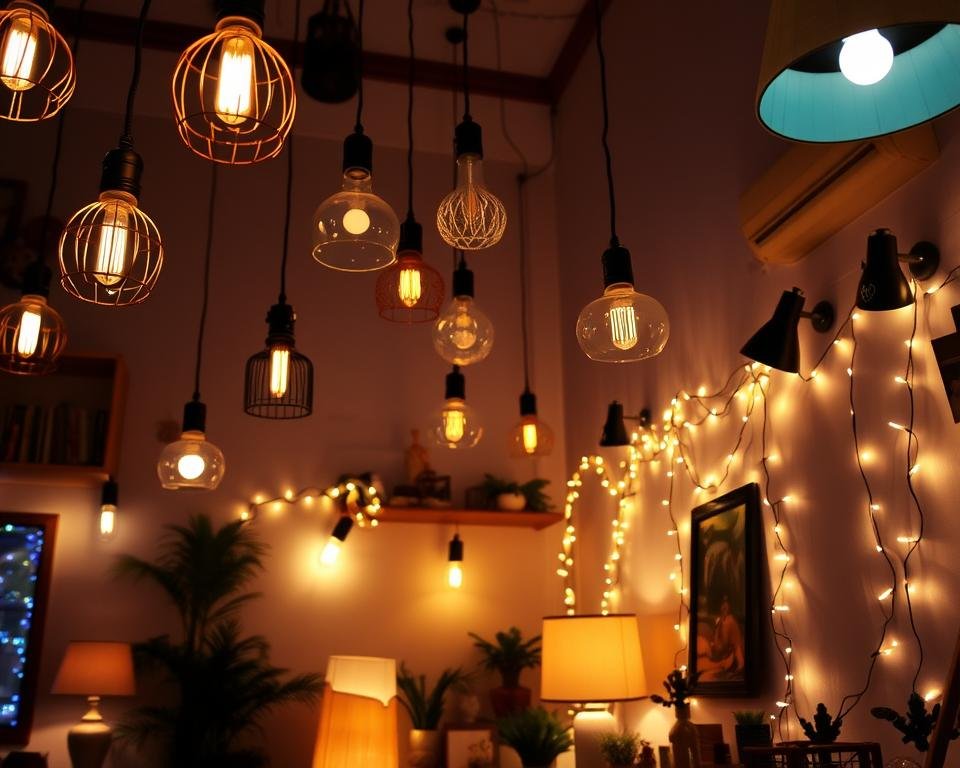
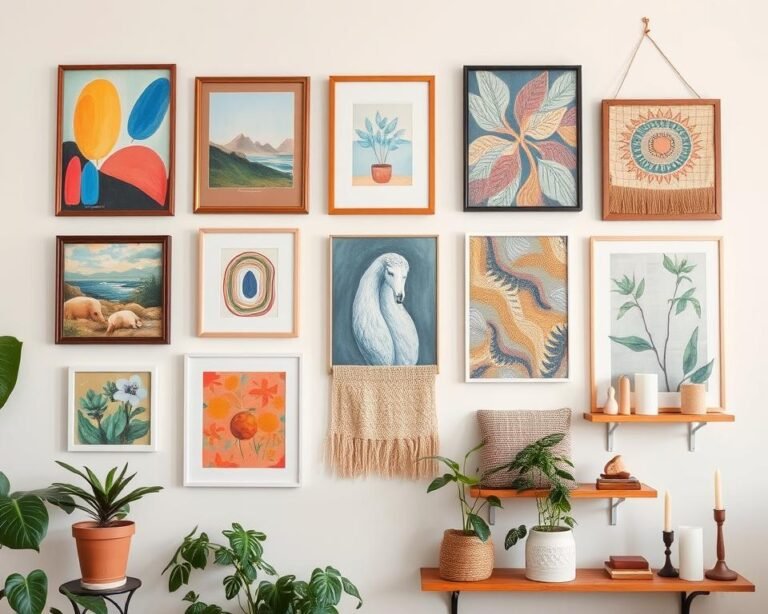
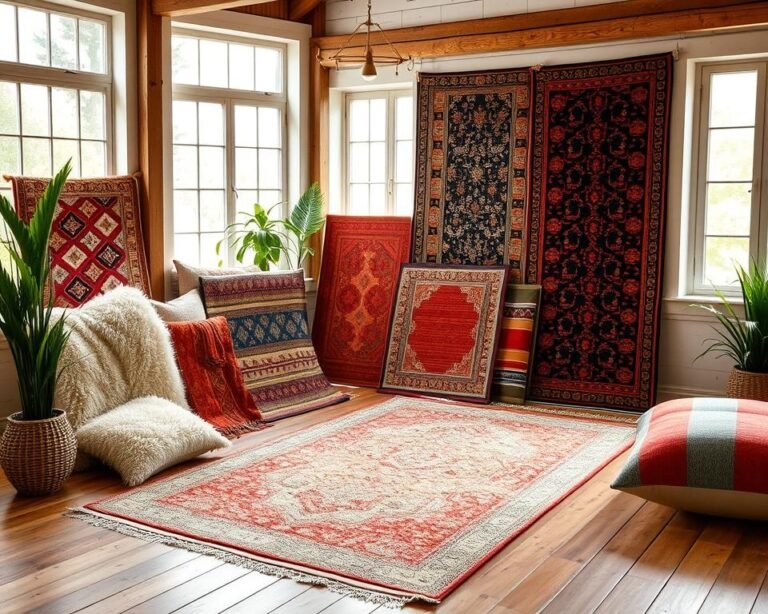
Leave a Comment